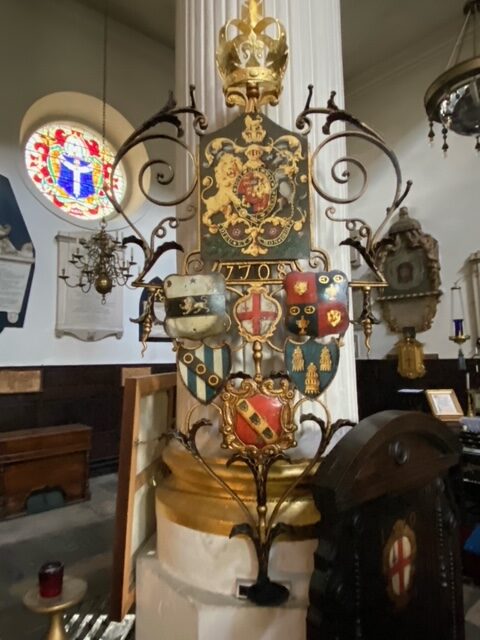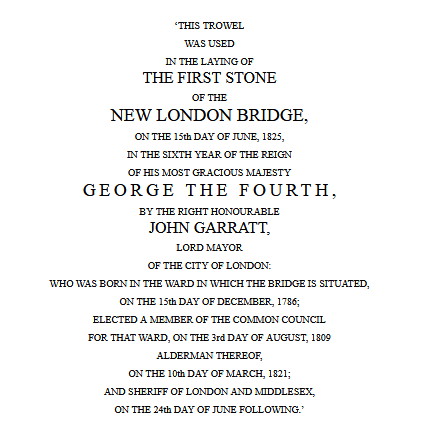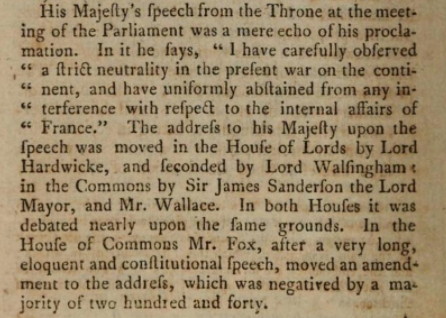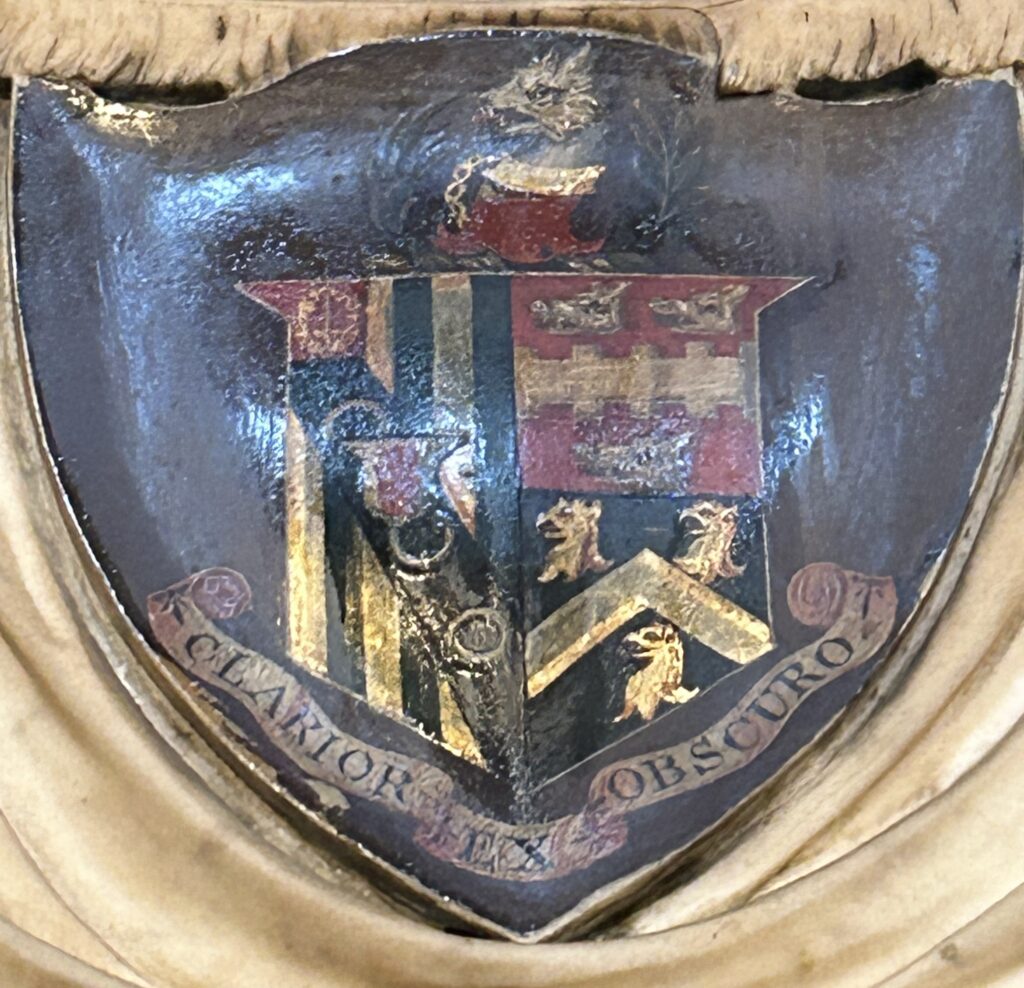The wrought iron mayoral sword rest is of elaborate scroll and foliate design with, at the apex, a gilded/gold-painted crown symbolising the Lord Mayor’s supreme civic authority within the City, which he puts aside in the church when he sets his sword on the sword rest, its pommel resting on the scallop shell-shaped dish at the base. Across the centre of the sword rest is the date 1708 and, now covered by the Royal Arms of George III, the monogram of Queen Anne (1702-1714). The sword rest dates from time of Sir Charles Duncombe’s mayoralty in 1708-9 and it is understood that he presented it to the church. An official seat for the Lord Mayor, bearing the date 1924 and the City Corporation’s heraldic shield, stands next to the sword rest.

Seven armorial shields are displayed on the sword rest as follows:
At the top, the Royal Arms, as used from 1801 to 1816 by King George III (1 & 4 England, 2 Scotland, 3 Ireland), with the escutcheon showing the arms of Hanover ensigned with the electoral cap, with mantling, crest, supporters, motto and the crown of England.
Below that the arms of John Garratt (Argent on a fess Sable a lion passant of the first. In chief a mullet Argent), the arms of the City of London, and the arms of Garratt’s livery company the Worshipful Company of Goldsmiths. John Garrett (1786-1859) was born in the Ward of Bridge Within of which he later became Alderman and was Lord Mayor in 1824-5, laying the first stone of the new London Bridge.

Below that, the (assumed) arms of Sir James Sanderson Bt (paly of six Argent and Azure on a bend Sable three annulets Or) and the arms of his livery company the Worshipful Company of Drapers. The arms officially granted to Sir James in 1794 are shown on his monument (see below).
At the bottom, in an ornate framing, the arms of Sir William Stephenson (Gules on a bend Or three leopards’ faces Sable). Sir William Stephenson was born in Alston, Cumbria where he provided for a market cross to be erected. He was a member of the Grocers’ Company and in 1754 was elected Alderman of Bridge Ward, Sheriff in 1757 and Lord Mayor in 1764-5. He died in 1774.
Sir James Sanderson, 1st Baronet (1741-1798) was born in York but began his adult life in London buying and selling hops before becoming a banker and MP for Malmesbury and then Hastings. He was also a social reformer, overhauling the management of Bridewell Royal Hospital of which he was president, and a supporter of William Wilberforce. He was an Alderman of Bridge Ward, Sheriff in 1785, and Lord Mayor in 1792-3 at the time of the declaration of war by the French Republic on 1 February 1793 and the panic arising from the activities of the radical societies. His portrait was painted by Gainsborough Dupont. Sir James was buried in St Magnus the Martyr.

Sir James Sanderson’s memorial, attributed to the family of his brother-in-law Samuel Fisher (one of a dynasty of stone carvers, sculptors and stonemasons who ran the most prominent sculpture business in Yorkshire in the 18th century), can be found on the wall of the south aisle. In his will Sir James left instructions for his funeral and burial, and specified that a marble monument should be erected costing at least £200 but no more than £300. The heraldry displayed on the memorial is as follows:
Arms – Paly of six Argent and Azure on a bend Sable three annulets Or, a canton Gules charged with a sword erect Argent, pomel and hilt Or, surrounded with the collar of the Lord Mayor of the City of London; baronet’s badge; impaled with the arms of his first wife Elizabeth Judd (1743-1793) Gules a fess raguly between three boars heads couped, and those of his second wife, Elizabeth Skinner (1771-1817), daughter of Thomas Skinner (1737-1806, Alderman for Queenhithe Ward, Lord Mayor 1794-95) Sable on a chevron Or between three griffins’ heads erased argent.
Crest – A wolf’s head erased Gules collared and chain reflexed behind the back Or, between a branch of palm and another of laurel
Motto – Clarior ex obscuro

The first Lady Sanderson died, when Lady Mayoress, at her home near Wandsworth on 17 August 1793 aged 50 without any surviving children. Sir James’s infant daughter and heiress, Elizabeth Sanderson (1796-1864), the only child of the second Lady Sanderson, married Richard Burdon (son of Sir Thomas Burdon). Their children included Sir John Burdon-Sanderson Bart FRS (1828-1905), Regius Professor of Medicine at Oxford University, and Mary Elizabeth Burdon-Sanderson (1825-1925), the mother of Richard Burdon Haldane, 1st Viscount Haldane of Cloan KT, OM, PC, FRS, FSA, FBA, KC (1856-1928) and John Scott Haldane CH FRS (1860-1936), and grandmother of JBS Haldane FRS and Naomi Mitchison (née Haldane) (Lady Mitchison) CBE.
Sanderson was in partnership with his brother-in-law, Henry Octavius Roxby (1741-1820) in the firm of Roxby & Co, hop merchants, of 3 London Bridge. Another partner in the firm was Matthew Armstrong (died 1801), whose memorial, next to Sanderson’s, shows his canting arms: [Gules] three dexter arms vambraced and embowed proper.
On the other side of Sanderson’s memorial is one to Miles Stringer (1733-99), spice merchant and tea dealer of Monument Yard, and his wife, Elizabeth Couzens Leach (1739-1806). The inscription records Stringer’s “most pleasing and unaffected urbanity of manners”. His arms (Argent a cross patonce between four martlets Sable, a canton Erminois) are impaled with that of his wife (Ermine on a chief dancettée Gules three Ancient Crowns Or); his crest: A martlet Gules.
In the Sacristry is a memorial to Sir John Thompson (c. 1669-1750), Vintner and Alderman of Candlewick Ward, who was Lord Mayor in 1736/37. He was narrowly defeated (by 11 votes) when he stood for election as MP for the City of London in 1727, but served as Governor of the Russia Company, a director of the South Sea Company and for four terms director of the Bank of England. He also had interests in the port of London, before passing them to his son-in-law, Sir William St Quintin Bt (1700-70), who married his daughter and heiress Rebecca.
